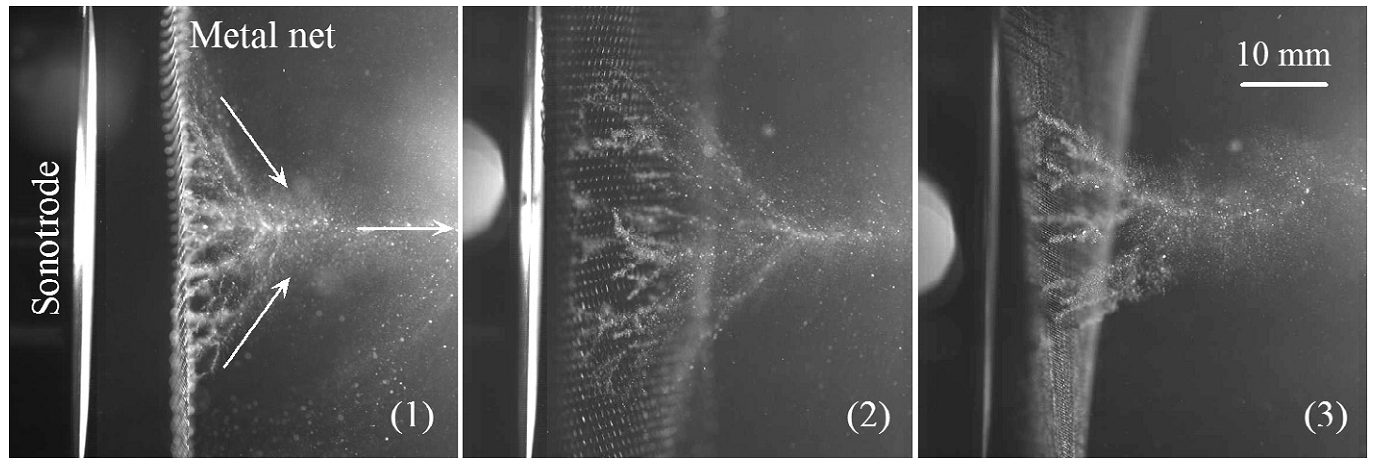Sonochemistry has been the subject of laboratory study for several decades, but success in scaling sonochemical reactions has been very limited. Some problems should be solved before significant commercial activities can occur. For example, the cavitation areas are small and very difficult to control, sonotrode or transducer erosion causes contamination of the liquid to be treated, and energy conversion efficiency and economical efficiency are poor. In order to solve the above problems, investigation on the generation and control of acoustic cavitation bubble cloud is needed.
BAI Lixin, DENG Jingjun, LI Chao and XU Delong from the Institute of Acoustics, Chinese Academy of Sciences investigate the generation and control of several typical acoustic cavitation structures (conical bubble structure, smoker, acoustic lichtenberg figure, tailing bubble structure and jet-induced bubble structures) in a 20-50 kHz ultrasonic field. During the research, the nuclei source of above-mentioned acoustic cavitation structures is analyzed, and the relationship and mutual transformation of these acoustic cavitation structures are discussed.
Structure of conical bubble and direction of smoker and tailing bubble structure are closely related to vibration mode of radiation surfaces (pressure field). These acoustic cavitation structures can be controlled by the pressure field and position of foreign bodies used for artificially implanting nuclei (see Fig.1).

Fig.1 The generation and control of smoker by artificial implants of nuclei (Image by BAI).
Cavitaiton structures (for example, conical bubble structure, smoker, tailing bubble structure, jet-induced bubble structure) are closely interrelated. They are interchangeable under given conditions. For a conical bubble structure whose radiating surface is covered by bubbly web structures, the conical structure can be considered as a product from the interaction of many tailing bubble structures (see Fig.2). And for a conical bubble structure whose radiating surface is covered by bubbly film (without pattern), the conical structure can be considered as a single large tailing bubble structure.

Fig. 2 The ACBS induced by metal net (Image by BAI).
Smoker and tailing bubble structure can be transformed into each other, and smoker can be considered as a special kind of tailing bubble structure which is attached to a surface. While the smoker structure can be evolved into Web structure, the tailing bubble structure can be considered as a special kind of jet-induced bubble structure (water-jet velocity is zero).
When the pressure amplitude P > P0 (P0 = 190 kPa) in the sound field is near a sonotrode, cavitation bubbles tend to move along the direction of pressure drop. That is the premise and the foundation of some acoustic cavitation structure formation (for example, conical bubble structure, smoker, tailing bubble structure, jet-induced bubble structure). On the other hand, when the pressure amplitude P < P0, cavitation bubbles tend to move along the direction of pressure rise (pressure antinode), which is the premise and the foundation of some acoustic cavitation structure formation (for example, acoustic Lichtenberg figure, or artificial conical bubble structure).
This research was supported by the National Natural Science Foundation of China (No. 11174315) (No. 51179114) and the National Science and Technology Major Project of China (No. 2011ZX05032-003).
Journal References:
BAI Lixin, XU Weilin, DENG Jingjun, LI Chao, XU Delong and GAO Yandong. Generation and Control of Acoustic Cavitation Structure. Ultrasonics Sonochemistry (vol. 21, pp. 1696–1706, MAR 2014).
Corresponding Author:
BAI Lixin
Ultrasonic Physics and Exploration Laboratory, Institute of Acoustics, Chinese Academy of Sciences, Beijing 100190, China
E-mail: lixin.bai@gmail.com


